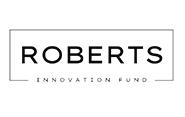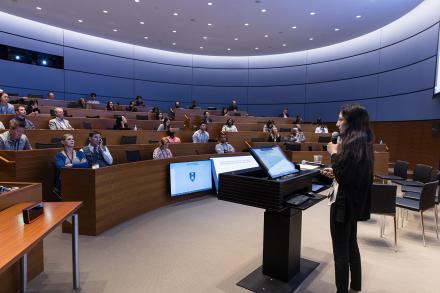From Better Health Care to Better Credit Scoring: Roberts Fund Awardees Present Their Projects

Automatic summaries of medical imaging, identifying certain molecules to stave off disease, and faster and more efficient computing were among the presentations from the inaugural cohort of awardees of the Roberts Innovation Fund at the Yale Innovation Summit.
Overseen by Jeffrey Brock, dean of the Yale School of Engineering & Applied Science and led by Claudia Reuter, director of the Roberts Innovation Fund at Yale Ventures, the Roberts Fund focuses on breakthrough technologies developed by Yale Engineering faculty. Supported by a generous gift from Yale alumnus Will Roberts ’90, the first Roberts Innovation Fund Awards provide $500,000 of accelerator funding to support nine new inventions led by Yale Engineering faculty. The Roberts Innovation Fund marks the School’s latest initiative to amplify its culture of innovation and entrepreneurship. In line with the Yale Engineering Strategic Vision, it’s designed to create an ecosystem that brings to market discoveries that will benefit humanity.
At the Innovation Summit May 31, representatives for each of the awarded projects gave short presentations on their work. Featured projects include:
 MoirAI
MoirAI
Like the cells that make up who we are, diseases are characterized by dynamics. Neurodegenerative diseases like Alzheimer's disease, for instance, have immune cells that change from homeostatic states to inflammatory degenerative states. Most diseases undergo some kind of progression, which makes them extremely hard to control. MoirAI, a start-up led by Smita Krishnaswamy, has assembled a team with joint expertise in mathematical artificial intelligence (AI), machine learning, and various biomedical fields with the goal of controlling cellular dynamics and identifying druggable molecules that drive diseases.
The system involves inputting longitudinal single-cell data collected on a disease progression system into MoirAI’s neural ordinary differential equation models, which automatically learn the disease dynamics.
“These inferred dynamics give different trajectories for each and every single cell,” said Krishnaswamy, associate professor of computer science and genetics. “So we learn the different states to which cells transition. This allows us to build underlying gene regulatory networks that give rise to these dynamics, and this is how we identify the target.”
The system has a wide range of potential applications. The first disease that the company is targeting is triple-negative breast cancer, one of the most diagnosed diseases in the U.S. among females, and one that is very difficult to treat without targeted therapies.
Disaggregated Clouds
Data centers can consume as much power as a city of two million people, and in total consume two percent of the world’s electricity. Larger data centers can comprise more than a million servers, each of which houses CPUs, memory, and storage. But they’re also very inefficient. Google’s data centers, for instance, use only 50% of their memory resources more than half of the time, which leads to millions of dollars in additional costs of operation – this is detrimental both financially and environmentally.
Disaggregated Clouds, a project led by Anurag Khandelwal, assistant professor of computer science, aims to change that by building disaggregated data centers that will lead to more cost-effective and cleaner cloud computing.
“The goal of our project is to build an operating system that can manage these resources and allow the applications to think of the entire data center as a single gigantic computer,” Khandelwal said. “Our team is composed of people with expertise in cloud systems and in data center architectures, and is uniquely equipped to achieve the goals of this project.”
Responding to the rapid increase in smart devices connected to the Internet of Things, the project will first focus on edge data centers.
CRAIG
Imaging studies are vital to many decisions about treatment, and the need for these studies is rapidly increasing. Radiologists, critical members of the medical community, are typically in demand, overworked, and underpaid. So any technology that can help them out is welcome. That’s where CRAIG (Computed Radiology Reporting with AI-assisted Generation) comes in. Led by co-principal investigators Arman Cohan, assistant professor of computer science, and Sophie Chheang, assistant professor of clinical radiology and biomedical imaging, CRAIG provides a system that uses AI to automatically generate the summary, or impression, of the radiology report.
“We support the workload so that we can help hospitals take care of more patients and make work more pleasant for radiologists,” as Dr. Chheang puts it.
Radiology reports have two components. The first is the objective description of the imaging, known as the findings. The second is the impression, which summarizes the findings and identifies its most clinically important aspects. Pretrained on a very large corpus of medical reports, the CRAIG system automatically generates the impression, thereby saving the radiologists a significant amount of time. Numerous radiologists tried out and praised the CRAIG system. One private practice radiologist described the system as “surprisingly accurate, given that it wasn't trained on my data.”
The other awardees are:
- Combining DEFI & AI for Intelligent Credit Scoring: Transforming the decentralized finance landscape and alleviating transaction risk via quantifying participant’s credit; Leandros Tassiulas - Electrical Engineering
- Deep Learning for Quantification of Lower Extremity Flow & Viability: Albert Sinusas, MD - Biomedical Engineering
- Lagrange: Non-interactive cross-chain state proofs; Charalampos Papamanthou - Computer Science
- Physics-Based Algorithm MRI: Inexpensive large-scale AI for prostate cancer using MR physics; Gigi Galiana & Hemant Tagare - Radiology & Biomedical Imaging and Biomedical Engineering (Co-PIs)
- ZIPNet: Anonymous Broadcast Made Practical with TEEs; Fan Zhang - Computer Science
- ZK4ALL: Establishing a standard programming framework for working efficiently with cloud-ready zero-knowledge proofs; Ruzica Piskac - Computer Science

